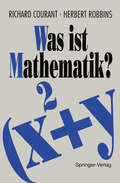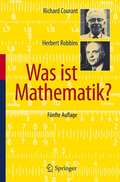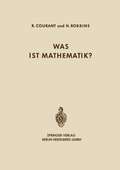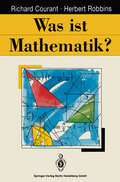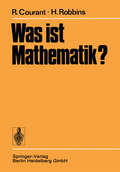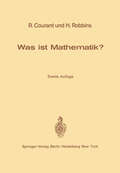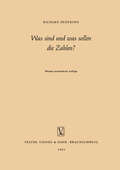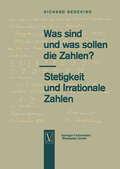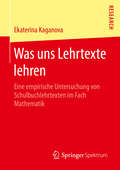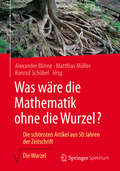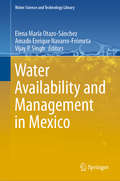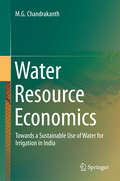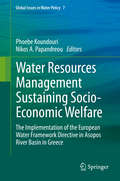- Table View
- List View
Was ist Mathematik?
by Richard Courant Herbert Robbins"Was ist Mathematik?" lädt jeden ein, das Reich der Mathematik zu betreten, der neugierig genug ist, sich auf ein Abenteuer einzulassen. Das Buch richtet sich an Leser jeden Alters und jeder Vorbildung. Gymnasiallehrer erhalten eine Fülle von Beispielen, Studenten bietet es Orientierung, und Dozenten werden sich an den Feinheiten der Darstellung zweier Meister ihres Faches erfreuen.
Was ist Mathematik?
by Richard Courant Herbert Robbins47 brauchen nur den Nenner n so groß zu wählen, daß das Intervall [0, Ijn] kleiner wird als das fragliche Intervall [A, B], dann muß mindestens einer der Brüche mfn innerhalb des Intervalls liegen. Also kann es kein noch so kleines Intervall auf der Achse geben, das von rationalen Punkten frei wäre. Es folgt weiterhin, daß es in jedem Intervall unendlich viele rationale Punkte geben muß; denn wenn es nur eine endliche Anzahl gäbe, so könnte das Intervall zwischen zwei beliebigen benachbarten Punkten keine rationalen Punkte enthalten, was, wie wir eben sahen, unmöglich ist. § 2. Inkommensurable Strecken, irrationale Zahlen und der Grenzwertbegriff 1. Einleitung Vergleicht man zwei Strecken a und b hinsichtlich ihrer Größe, so kann es vor kommen, daß a in b genau r-mal enthalten ist, wobei r eine ganze Zahl darstellt. In diesem Fall können wir das Maß der Strecke b durch das von a ausdrücken, indem wir sagen, daß die Länge von b das r-fache der Länge von a ist. Oder es kann sich zeigen, daß man, wenn auch kein ganzes Vielfaches von a genau gleich bist, doch a in, sagen wir, n gleiche Strecken von der Länge ajn teilen kann, so daß ein ganzes Vielfaches m der Strecke ajn gleich b wird: (1) b=~a.
Was ist Mathematik?
by Richard Courant Herbert RobbinsMathematik ist nicht jedermanns Sache. Wer sie liebt, für den ist sie spannend und aufregend wie das schönste Rätsel. Für viele Menschen aber ist Mathematik ein Buch mit sieben Siegeln, das man ehrfurchtsvoll den "Eingeweihten" überläßt. Das Ziel von "Was ist Mathematik?" ist es, Brücken zu schlagen und jeden einzuladen, das Reich der Mathematik zu betreten, der neugierig genug ist, sich auf ein Abenteuer einzulassen. Die Autoren verschweigen nicht, daß Mathematik neben Begabung auch viel Fleiß und Mitdenken erfordert: man sollte sich mit ihr beschäftigen, nicht nur über sie philosophieren. Wer aber bereit ist, beides einzusetzen, den führen die Autoren mit großem Geschick und anschaulichen Hilfsmitteln hin zu einem Einblick in das innere Gefüge der Mathematik sowie ihrer historischen Entwicklung. Behandelt werden die Fragenkomplexe: Zahlen, geometrische Konstruktionen, Algebra der Zahlkörper, projektive Geometrie, Axiomatik, nichteuklidische Geometrien, Topologie, Funktionen, Grenzwerte, Extrema und Infinitesimalrechnung. "Was ist Mathematik?" ist für Leser jeden Alters und jeder Vorbildung gedacht. Gymnasiallehrer finden eine reiche Auswahl an Beispielen, Studenten ist es ein Leitfaden, wenn sie die Orientierung zu verlieren meinen, und Dozenten werden sich an den Feinheiten der Darstellung zweier Meister ihres Faches erfreuen.
Was ist Mathematik?
by Richard Courant Herbert Robbins47 brauchen nur den Nennern so groß zu wählen, daß das Intervall [0, 1/n] kleiner wird als das fragliche Intervall [A, B], dann muß mindestens einer der Brüche mfn innerhalb des Intervalls liegen. Also kann es kein noch so kleines Intervall auf der Achse geben, das von rationalen Punkten frei wäre. Es folgt weiterhin, daß es in jedem Intervall unendlich viele rationale Punkte geben muß; denn wenn es nur eine endliche Anzahl gäbe, so könnte das Intervall zwischen zwei beliebigen benachbarten Punkten keine rationalen Punkte enthalten, was, wie wir eben sahen, unmöglich ist. § 2. Inkommensurable Strecken, irrationale Zahlen und der Grenzwertbegriff 1. Einleitung Vergleicht man zwei Strecken a und b hinsichtlich ihrer Größe, so kann es vor kommen, daß a in b genau r-mal enthalten ist, wobei r eine ganze Zahl darstellt. In diesem Fall können wir das Maß der Strecke b durch das von a ausdrücken, indem wir sagen, daß die Länge von b das r-fache der Länge von a ist. Oder es kann sich zeigen, daß man, wenn auch kein ganzes Vielfaches von a genau gleich b ist, doch a in, sagen wir, n gleiche Strecken von der Länge afn teilen kann, so daß ein ganzes Vielfaches m der Strecke afn gleich b wird: b=!!!..a.
Was ist Mathematik?
by Richard Courant Herbert Robbins47 brauchen nur den Nenner n so groß zu wählen, daß das Intervall [0, IJn] kleiner wird als das fragliche Intervall [A, B], dann muß mindestens einer der Brüche m/n innerhalb des Intervalls liegen. Also kann es kein noch so kleines Intervall auf der Achse geben, das von rationalen Punkten frei wäre. Es folgt weiterhin, daß es in jedem Intervall unendlich viele rationale Punkte geben muß; denn wenn es nur eine endliche Anzahl gäbe, so könnte das Intervall zwischen zwei beliebigen benachbarten Punkten keine rationalen Punkte enthalten, was, wie wir eben sahen, unmöglich ist. § 2. Inkommensurable Strecken, irrationale Zahlen und der Grenzwertbegriff 1. Einleitung Vergleicht man zwei Strecken a und b hinsichtlich ihrer Größe, so kann es vor kommen, daß a in b genau r-mal enthalten ist, wobei r eine ganze Zahl darstellt. In diesem Fall können wir das Maß der Strecke b durch das von a ausdrücken, indem wir sagen, daß die Länge von b das r-fache der Länge von a ist.
Was uns Lehrtexte lehren: Eine empirische Untersuchung von Schulbuchlehrtexten im Fach Mathematik
by Ekaterina KaganovaEkaterina Kaganova untersucht, was und wie gut Schulbuchlehrtexte im Fach Mathematik lehren. Zunächst konzipiert die Autorin das Konstrukt „Lehrpotential eines (Mathematik-)Schulbuchlehrtextes“ auf Basis der kognitionspsychologischen Schematheorie und unter Einbeziehung textlinguistischer Ansätze als eine analytisch zugängliche Größe. Anschließend wird das Lehrpotential von ausgewählten Lehrtexten aktueller Mathematikschulbücher für die Jahrgangsstufen 6 und 7 analysiert. Insbesondere durch den empirischen Nachweis, dass die öffentlich vertretenen Ansprüche hinsichtlich des Lehrens im Mathematikunterricht faktisch nicht eingelöst werden, gewinnen die Analyseergebnisse an gesellschaftlicher Brisanz.
Was wäre die Mathematik ohne die Wurzel?: Die schönsten Artikel aus 50 Jahren der Zeitschrift Die Wurzel
by Alexander Blinne Matthias Müller Konrad SchöbelIn diesem Jubiläumsband erscheinen zum 50. Geburtstag der Zeitschrift „Die Wurzel“ die schönsten Artikel aus 50 Jahren, garniert mit zahlreichen Anekdoten und Kuriositäten aus der Zeitschriftengeschichte und dem Redaktionsalltag.Was kostet der Flug zu den Sternen? Wie kann man die Oberfläche einer Kugel parkettieren? Hat das Tragseil einer Brücke die Form einer Kettenlinie oder die einer Parabel?Mit Artikeln zu solchen und vielen anderen Themen hat die Mathematik-Zeitschrift "Die Wurzel" über Jahre hinweg Schüler, Studierende und Mathematik-Interessierte im Allgemeinen begeistert.Ein Buch zum Schwelgen in Erinnerungen für diejenigen, denen die Wurzel ein Begriff ist – und zum Kennenlernen "....dieses einzigartigen Kleinods in der deutschen Mathematikszene..." (Zitat Albrecht Beutelspacher) für alle anderen.
The Washington State Census Board and Its Demographic Legacy (SpringerBriefs in Population Studies)
by David A. SwansonThis book tells the story of how a group of far-sighted, academic researchers came to the aid of an overwhelmed local government. It details the history of the Washington State Census Board, which began in 1943 as part of an emergency measure during a massive wartime in-migration. The narrative also shows the demographic legacy of the Board and, ultimately, provides an unforgettable look into the creation and evolution of applied demography.Inside, readers will discover how Washington State struggled to keep up with the unexpected needs for housing, transportation, schools, and public utilities for the hundreds of thousands of migrants who came to work in industries that practically developed overnight with the mobilization for World War II. The author recounts how Professor Calvin F. Schmid, who led the Washington State Census Board, and his team developed methods of population estimation that are still in use today.In the process, the narrative reveals how population figures were gathered, compared, and projected at a time when the hand calculator was considered cutting-edge technology. The book also details how methods were refined and improved over time as well as how those involved developed new ways to obtain and, more importantly, utilize the information. With the aid of archived materials, personal interviews, and rich personal accounts, this book will inform and inspire practicing and academic demographers as well as planners, policy-makers, historians, and interested readers.
The Waste Market: Institutional Developments in Europe
by Elbert Dijkgraaf Raymond H. J. M. GradusE. Dijkgraaf and R. H. J. M. Gradus 1. 1 Introduction In 2004 Elbert Dijkgraaf nished a PhD-thesis ‘Regulating the Dutch waste market’ at the Erasmus University Rotterdam. It was interesting that not much is published about the waste market, although it is a very important sector from an economic and environmental viewpoint. In 2006 we were participants at a very interesting conf- ence on Local Government Reform: privatization and public-private collaboration in Barcelona organized by Germa ` Bel. It was interesting to notice that researchers from Spain, Scandinavian countries, the UK and the USA were studying this issue as well. From this we brought forward the idea to publish a book about the waste market. Because of its legal framework we want to focus on Europe. In this chapter we give an introduction to this book. In the next paragraph we present a short overview of the waste collection market. Since 1960 the importance of the waste sector has increased substantially both in the waste streams and the costs of waste collection and treatment. Furthermore, we discuss policy measures to deal with these increases and give an overview of the different measures in - countries. In the last paragraph we present different chapters of our book. 1. 2 Empirical Update of the Waste Collection Market The Dutch case provides a nice example why studying the waste market is int- esting from an economic point of view.
Water Availability and Management in Mexico (Water Science and Technology Library #999)
by Vijay P. Singh Amado Enrique Navarro-Frómeta Elena María Otazo-SánchezThis book presents several complex case studies related to water management and planning in the context of pollution, growing demands, and global climate change in Mexico, but which are also relevant for other countries in Latin America. These concerns are of critical importance for policymakers who are coping with multiple conflicting interests. Water availability in Mexico is polarized, with abundant rainfall and large rivers in the south, and desert-like conditions in the north. The central region, which is the most industrialized, is overpopulated. Mexico City pours millions of cubic meters of “blackwater” into the northern valley daily and receives its clean water from the south. To address these unsustainable conditions, the world's 4th biggest water treatment plant went into operation in 2018. The water infrastructure and governance must satisfy the demands of all sectors, including agricultural, urban, and economic activities. At the same time, water resources are affected by drought, and climate change puts constraints on the supply. As such, regulation and monitoring are important when it comes to adherence to agreed plans and priorities. The book is divided into four sections. 1: Water Availability discusses quantitative aspects, such as supply, methods of calculation, and fracking. 2: Water Quality highlights pollution risks and diagnosis of water resources. 3: Water Allocation examines the sectoral demands and vulnerability due to unsustainable irrigation. 4: Water Governance and Management focuses on laws, urban rules, national parks, planning, and integrated water resources management, among other topics. The chapters include illustrative case studies in Mexico, such as basins, cities, reservoirs, and aquifers, water supply demand assessment, planning, and management.
Water Informatics: Challenges and Solutions Using State of Art Technologies (Water Informatics for Water Resource Management)
by Arindam Biswas Sheng-Lung Peng Supreeti KamilyaThis book provides a clear view of various applications for water resource management using different state-of-the-art technologies such as artificial intelligence, IoT, and cellular automata. The book also shows the analytical part of surface water as well as groundwater bodies to control pollution and save ecology. It gives an idea about the collection of data for disaster management such as flood prediction and flood inoculation. The book provides the fundamental aspects of various computational or simulation methods for surface and underground water body detection, prediction of non-biodegradable elements in water bodies, water potability, and predictions of natural disasters like floods. The book summarizes different aspects of water body challenges and the possible solutions proposed using new technologies. The book opens up a future research direction of dealing with various challenges and solutions based on emerging technologies. This book comes up with a direction for the researchers interested in dealing with various aspects of water challenges and finding solutions using emerging technologies in the new era of modern computations.
Water Quality Management: Assessment and Interpretation (SpringerBriefs in Water Science and Technology)
by Gholamreza AsadollahfardiConsidering the significance of water quality for drinking, irrigation and industry, availability of accurate and sufficient water quality data is necessary and having enough data without proper interpretation is not helpful for water quality management decisions.Hence, analysis of the existing data and prediction of future of water quality is vital. The current volume first defines the importance of water quality parameters regarding public health and irrigation. Secondly, the climatic situation and hydrological cycle of the area is considered for interpretation of the data.Various methodologies such as Box-Jenkins time series analysis, water quality indices, artificial neural networks and principal component analysis are described and applied to actual data for different environmental conditions such as arid, semiarid and mountainous areas.This book is a user manual for students and professionals involved in water quality planning and management.
Water Resource Economics: Towards a Sustainable Use of Water for Irrigation in India
by M.G. ChandrakanthThis book uses resource economics costing approaches incorporating externalities to estimate the returns for the country’s irrigation and demonstrates how underestimating the cost of water leads farmers to overestimate profits. The importance of the subject can be judged in light of the fact that India is the largest user of groundwater both for irrigation and for drinking purposes, pumping twice as much as the United States and six times as much as Europe.Despite water’s vital role in ensuring economic security for the nation and farmers alike by supporting more than 70% of food production, water resource economists are yet to impress upon farmers and policymakers the true value of water and the urgent need for its sustainable extraction, recharge and use. In an endeavor to promote more awareness, the book further delineates the roles of the demand side and supply side in the economics of irrigation, and explains how the cost of water varies with the efforts to recharge it, crop patterns, degrees of initial and premature well failure and degrees of externalities. It also discusses the importance of micro-irrigation in the economics of saving water for irrigation, estimating the marginal productivity of water and how it improves with drip irrigation, the economics of water sharing and water markets, optimal control theory in sustainable extraction of water, payment of ecosystem services for water and how India can effectively recover.In closing, the book highlights the role of socioeconomic and hydrogeological factors in the economics of irrigation, which vary considerably across hard rock areas and the resulting limitations on generalizing.
Water Resources Engineering Risk Assessment (Nato ASI Subseries G: #29)
by Jacques GanoulisAlthough many theoretical developments have been achieved in recent years, the progress both in understanding and application of risk and reliability analysis in water resources and environmental engineering remains slow. One of the reasons seems to be the lack of training of engineers with phenomena of statistical nature, including optimum cost and benefit decisions under uncertainty. This book presents, in a unified and comprehensive framework, the various aspects of risk and reliability in bothwater quantity and quality problems. The topics covered include uncertainty analysis of water quantity and quality data, stochastic simulation of hydrosystems, decision theory under uncertaintyand case studies. Methods for risk analysis of extremes in hydrology, groundwater clean-up, river and coastal pollution as well as total risk management are presented.
Water Resources Management Sustaining Socio-Economic Welfare: The Implementation of the European Water Framework Directive in Asopos River Basin in Greece (Global Issues in Water Policy #7)
by Phoebe Koundouri Nikos A. PapandreouThe aim of this book is to offer a river-basin management plan which is directly implementable and consistent with the European Union -Water Framework Directive (EU WFD).The contributors, who are leading world experts in their respective fields, develop an integrated water resources management plan for the Asopos river basin in Greece which is economically efficient, socially equitable and environmentally sustainable. The program offers explicit technical and investment solutions, socioeconomic and legal instruments and recommendations for institutional restructuring. The introductory chapter describes the water situation in Greece and assesses the potential of timely implementation of the EU WFD. Special emphasis is given to the cost-recovery principle. Chapter 2 introduces the case study area highlighting the particular pressures and impacts as well as the environmental functions and values of Asopos River and Oropos Lagoon. Chapters 3 and 4 focus on the economic characterisation of Asopos River Basin in order to identify the economic sectors and social groups that will bear the cost and benefits of the implementation of the EU WFD. In particular, Chapter 3 presents the main water uses and pricing for water supply in the industrial and the agricultural sectors. Chapter 4 completes the baseline appraisal, presenting the details of water use by the residential and touristic sectors. The following chapters assess valuation and decision-making tools from a range of perspectives, including agricultural needs, valuing the impacts of industrial activity, the costs and benefits of environmental preservation and management. The water resources management plan is presented in Chapter 9; the concluding chapter offers recommendations on institutional changes and presents the lessons learned as resources applicable to other river basins in Greece and elsewhere. The book applies state-of-the art market and non-market valuation methods to estimate water demands in the residential, industrial, agricultural, tourism, environmental and health sectors and to balance these, over time and space, with water supply. Given the well-known challenge of managing natural resources in a way that maximizes and sustains social welfare, this book will provide an invaluable point of reference for applied researchers and policy makers working in water resources management.
Water Wave Scattering
by Birendra Nath Mandal Soumen DeThe theory of water waves is most varied and is a fascinating topic. It includes a wide range of natural phenomena in oceans, rivers, and lakes. It is mostly concerned with elucidation of some general aspects of wave motion including the prediction of behaviour of waves in the presence of obstacles of some special configurations that are of interes
Water Waves: The Mathematical Theory with Applications (Wiley Classics Library #36)
by J. J. StokerOffers an integrated account of the mathematical hypothesis of wave motion in liquids with a free surface, subjected to gravitational and other forces. Uses both potential and linear wave equation theories, together with applications such as the Laplace and Fourier transform methods, conformal mapping and complex variable techniques in general or integral equations, methods employing a Green's function. Coverage includes fundamental hydrodynamics, waves on sloping beaches, problems involving waves in shallow water, the motion of ships and much more.
Water Waves and Ship Hydrodynamics: An Introduction
by A.J. HermansIn this book an introduction is given to aspects of water waves that play a role in ship hydrodynamics and offshore engineering. At first the equations and linearized boundary conditions are derived describing the non-viscous free surface water waves, with special attention to the combination of steady and non-steady flow fields. Then some simple kinds of free wave solutions are derived, such as plane waves and cylindrical waves. For several situations, steady and unsteady, the source singularity function is derived. These functions play a role in numerical codes used to describe the motion of ships and offshore structures. These codes are mostly based on a boundary integral formulation; therefore we give an introduction to these methods. It is shown how first order ship motions can be determined. In offshore engineering the second order wave drift motions play an important role. An introduction to this phenomenon is given and the effects which have to be taken into account are explained by means of a simple example where we can determine nearly all the aspects analytically. An interesting example that is worked out is the motion of very large floating flexible platforms with finite draft. Finally an introduction to the theory of shallow water non-linear dispersive waves is presented, and shallow water ship hydrodynamics, that plays a role in coastal areas and channels is treated. Here attention is paid to the interaction between passing ships in restricted water. In the appendix a short introduction to some of the mathematical tools is given.
Waterflooding Sandstone Reservoirs: Methods, Design and Analysis
by Jiahong WangThis book focuses on oilfield performance analysis and development adjustment by integrating geology, applied mathematics, and other relevant theories. Based on the abundant and detailed field test and production data from Daqing and Tarim, two major oilfields in China, the regularities, characteristics, design, and adjustment of waterflooding development of sandstone reservoirs throughout the life cycle are described. Field development theories and practices are organically combined in this book, which, embracing comprehensive, systematic, and pragmatic contents, is conducive to development technicians to quickly grasp the characteristics of waterflooding and prepare adjustment plans. It is also useful as a textbook in petroleum colleges and short training courses.
Wave Equations in Higher Dimensions
by Shi-Hai DongHigher dimensional theories have attracted much attention because they make it possible to reduce much of physics in a concise, elegant fashion that unifies the two great theories of the 20th century: Quantum Theory and Relativity. This book provides an elementary description of quantum wave equations in higher dimensions at an advanced level so as to put all current mathematical and physical concepts and techniques at the reader’s disposal. A comprehensive description of quantum wave equations in higher dimensions and their broad range of applications in quantum mechanics is provided, which complements the traditional coverage found in the existing quantum mechanics textbooks and gives scientists a fresh outlook on quantum systems in all branches of physics. In Parts I and II the basic properties of the SO(n) group are reviewed and basic theories and techniques related to wave equations in higher dimensions are introduced. Parts III and IV cover important quantum systems in the framework of non-relativistic and relativistic quantum mechanics in terms of the theories presented in Part II. In particular, the Levinson theorem and the generalized hypervirial theorem in higher dimensions, the Schrödinger equation with position-dependent mass and the Kaluza-Klein theory in higher dimensions are investigated. In this context, the dependence of the energy levels on the dimension is shown. Finally, Part V contains conclusions, outlooks and an extensive bibliography.
Wave Factorization of Elliptic Symbols: Introduction to the Theory of Boundary Value Problems in Non-Smooth Domains
by V. Vasil'evTo summarize briefly, this book is devoted to an exposition of the foundations of pseudo differential equations theory in non-smooth domains. The elements of such a theory already exist in the literature and can be found in such papers and monographs as [90,95,96,109,115,131,132,134,135,136,146, 163,165,169,170,182,184,214-218]. In this book, we will employ a theory that is based on quite different principles than those used previously. However, precisely one of the standard principles is left without change, the "freezing of coefficients" principle. The first main difference in our exposition begins at the point when the "model problem" appears. Such a model problem for differential equations and differential boundary conditions was first studied in a fundamental paper of V. A. Kondrat'ev [134]. Here also the second main difference appears, in that we consider an already given boundary value problem. In some transformations this boundary value problem was reduced to a boundary value problem with a parameter . -\ in a domain with smooth boundary, followed by application of the earlier results of M. S. Agranovich and M. I. Vishik. In this context some operator-function R('-\) appears, and its poles prevent invertibility; iffor differential operators the function is a polynomial on A, then for pseudo differential operators this dependence on . -\ cannot be defined. Ongoing investigations of different model problems are being carried out with approximately this plan, both for differential and pseudodifferential boundary value problems.
